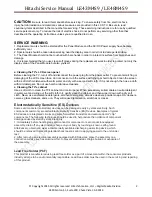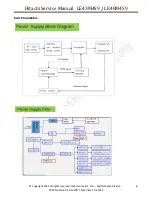
Hitachi Service Manual LE43M4S9 / LE48M4S9
©
Copyright
2015
All
rights
reserved
Hitachi
America,
Ltd.
–
Digital
Media
Division
2
2420
Fenton
St.,
Suite
200
Chula
Vista
CA
91914
CAUTION:
Be sure to read this manual before servicing. To ensure safety from fire, electric shock,
injury,harmful radiation and materials, various measures are provided in this LCD TV. Be sure to read
cautionary items described in the manual before servicing. These servicing instructions are for use by qualified
service personnel only. To reduce the risk of electric shock, do not perform any servicing other than that
described in the operating instructions unless you are qualified to do so.
SERVICE WARNING
1. Replacement work should be started after the Panel Module and the AC/DC Power supply have become
sufficiently cool.
2. Special care should be taken when working near the display area in order not to damage its surface.
3. The Panel Module should not be touched with bare hands in order to protect its surface from blemishes and
damage.
4. It is recommended that you use clean soft gloves during the replacement work in order to protect not only the
display area of the Panel Module but also yourself.
●
Cleaning the TV’s LCD screen panel
Before cleaning the TV, turn it off and disconnect the power plug from the power outlet. To prevent scratching or
damaging of the LCD screen face, do not knock or rub the surface with sharp or hard objects. Clean the screen
with a soft cloth moistened with warm water and dry with a second soft cloth. If it is not enough, then use a cloth
with mild detergent. Do not use harsh or abrasive cleaners.
●
Cleaning the TV's cabinet
Use a soft cloth to clean the TV's cabinet and control panel. When excessively soiled, dilute a neutral detergent
in water, wet and wring out the soft cloth in it, gently clean the cabinet, and then wipe it down with a dry soft
cloth. Never use acid/alkaline detergents, alcoholic detergents, abrasive cleaners, powder soaps, OA cleaners,
car wax, glass cleaners, and so on. They will cause discoloration, scratches or cracks.
Electrostatically Sensitive (ES) Devices
Some semiconductor (solid-state) devices can be damaged easily by static electricity. Such
components commonly are called Electrostatically Sensitive (ES) Devices. Examples of typical
ES devices are integrated circuits and some field-effect transistors and semiconductor "chip"
components. The following techniques should be used to help reduce the ncidence of component
damage caused by static by static electricity.
1. Immediately before handling any semiconductor component or semiconductor-equipped
assembly, drain off any electrostatic charge on your body by touching a known earth ground.
Alternatively, obtain and wear a commercially available discharging wrist strap device, which
should be removed to prevent potential shock reasons prior to applying power to the unit under
test.
2. After removing an electrical assembly equipped with ES devices, place the assembly on a
conductive surface such as aluminum foil, to prevent electrostatic charge buildup or exposure of
the assembly.
Lead Free Solder (PbF)
This product is manufactured using lead-free solder as a part of a movement within the consumer products
industry at large to be environmentally responsible. Lead-free solder must be used in the servicing and repairing
of this product.




































